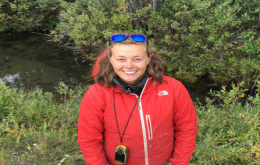
1.How did Swenarton originally plan to become an engineer?
A By attending a leading university.
B By cooperating with other people.
C By performing experiments in nature.
D By doing thorough research in the office.
解析:选D。细节理解题。根据第一段第四句“I realized I would be spending much time in the office,” she says.可知她起初认为通过在办公室做研究就能成为工程师。故选D。
2.What did Swenarton study as a university student?
A Organisms.
B Lionfish.
C Grayling.
D Ecology.
解析:选B。细节理解题。根据第三段第一、二句Swenarton came to Toolik after finishing her Master's degree at North Florida University in Jacksonville. There she’d studied lionfish, an invasive species eating up local fish.可知她大学期间研究了狮子鱼。故选B。
3.What is the focus of Swenarton’s efforts in Alaska?
A Catching more small fish.
B Studying a cold ecosystem.
C Studying a certain kind of fish.
D Trying a different lifestyle.
解析:选C。细节理解题。根据第三段最后两句She came to Alaska to collect data on a species of fish called Arctic grayling. She also studies the streams and rivers where the fish live.和综合第四段可知她一天的工作重心就是研究河鳟。故选C。
4.What can be inferred about the Toolik Field Station from the passage?
A It is especially remote.
B It is quite suitable for living.
C It is home to many scientists.
D Its transportation is convenient.
解析:选A。推理判断题。根据第五段第二、三句It’s located on a large gravel area right off the Dalton Highway — one of the only roads going through the North Slope Borough, which is at the top of Alaska. It's a several-hour drive to the nearest gas station, let alone the nearest town.可推断此处非常偏远。故选A。
5.What can be learned about Swenarton’s daily life from the passage?
A She is very fond of pets.
B She often holds social parties.
C She likes travelling by plane.
D She is very interested in water.
解析:选A。推理判断题。根据最后一段最后两句The hardest part for her, she says, is that her dog can’t come to Alaska, too. “I really struggle not being with her.”可推断她日常生活中非常喜欢宠物。故选A。